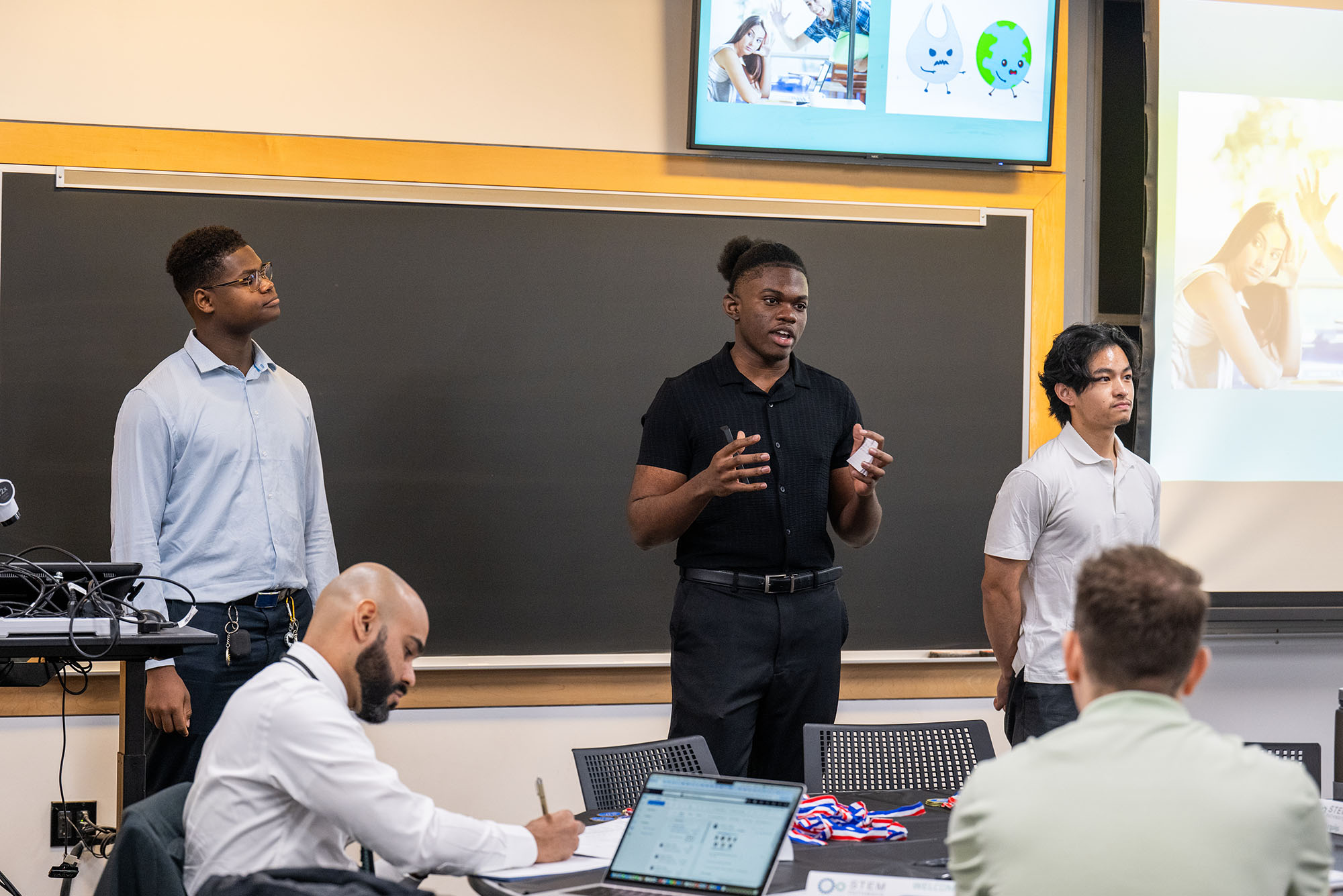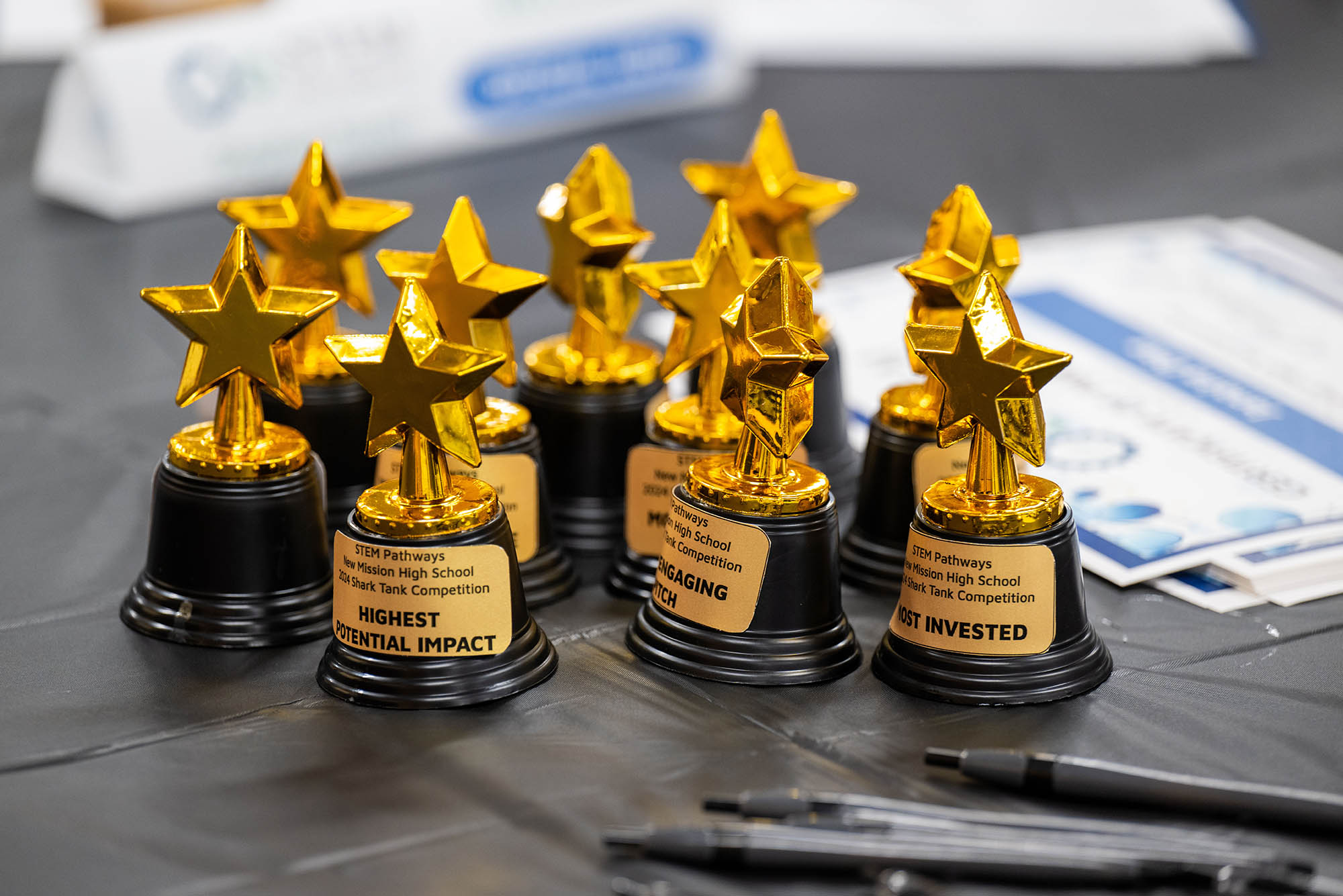Boston Teens Pitch Biotech Concepts to BU “Investors” at Biological Design Center’s STEM Pathways Event
Seniors from New Mission High School compete in annual Shark Tank-like event, with help from BU undergrad and grad student mentors

New Mission High School seniors Darareaksmey Chhim (from left), Mario Fils, and Dorian Planto pitching their plastic-eating bacteria concept at BU’s Biological Design Center’s Synthetic Biology Shark Tank Competition April 26.
Boston Teens Pitch Biotech Concepts to BU “Investors” at Biological Design Center’s STEM Pathways Event
Seniors from New Mission High School compete in annual Shark Tank–like event, with help from BU undergrad and grad student mentors
Swallowing jitters and marshaling a semester’s worth of research, 11 teams of local high schoolers arrived at Boston University on a recent spring day to pitch products to a panel of BU faculty and affiliates playing the part of skeptical investors. It was the second annual Synthetic Biology Shark Tank Competition, which was held at the BU Life Sciences & Engineering Building April 26.
Mentored by undergrad and graduate students from BU’s College of Engineering, the 28 seniors from Boston’s diverse New Mission High School conceived of, and fleshed out, synthetic biology solutions to real-world problems. Among the products they pitched: crops modified to survive unseasonable cold snaps; marine bacteria engineered to clean up oil spills; and a microorganism that warns mountain climbers of impending altitude sickness.
No actual dollars were invested in these on-paper concepts, but the experience taught the students valuable skills and got them thinking like real engineers and biotech developers.
“Eventually, I want to run a lab that does its own research,” says Mario Fils, whose team proposed Jurassic Plastic (tagline: “Making Plastic Extinct”), a plastic-eating bacteria that would be deployed in landfills, where at least half of plastic waste ends up. “The deeper I got into it, the more I realized that this is a big, big issue. So I can see myself continuing this research and maybe even releasing the product that we came up with.”
“Whether in academia or industry, you have to get your stuff funded,” says Sarah Goldberg, the students’ biotechnology instructor at New Mission High. “Either to get grants for your research or to get investors to invest in your product, you have to pitch your idea.”
And students chose these ideas on their own. “I didn’t give them a list of topics,” Goldberg says. “I said, ‘What matters to you? What interests you?’ And that’s where we start. Some of them picked plastic degradation or treating heroin addiction or detecting and treating high blood pressure. No matter how far they get into the actual science, they’re pushing themselves to learn and create in some form.”
Jackelyn Merida wanted to tackle cancer because “it has impacted my family,” she says. “At a young age I witnessed my grandmother go through stage 4 breast cancer, and recently my uncle was diagnosed with lymphoma cancer.”
Merida suggested focusing on inflammatory breast cancer (IBC), a rare and aggressive type of breast cancer with worse outcomes for people of color, and her teammate Calia Sutton agreed.
“As a woman of color, the fact that we have a higher death rate [from IBC] struck me,” Sutton says. “Not only is it a disease that is causing extraordinary pain, and the cost to treat it is atrocious, but my people are suffering and there’s not enough being done about it.”

That kind of disparity is a big part of why BU’s Biological Design Center launched STEM Pathways, the STEM outreach program that sponsored the competition. When technology is developed without diverse perspectives integrated into the process from the outset, the results can be things like pulse oximeters and facial recognition programs that are stymied by brown skin, as well as uneven treatment for some diseases.
“I can’t expect them all to go into biotech,” Goldberg says of her students, “but before they come into the class, they don’t even know it’s an option.”
Goldberg’s class at New Mission slightly predates STEM Pathways, but her students have benefited a great deal from the partnership over the past couple of years, she says. Many of the competitors at the Shark Tank event had attended Saturday STEM workshops at BU, and several worked full-time for five weeks last summer in labs at the BU Biological Design Center. Merida, for example, helped Wilson Wong, an ENG associate biomedical engineering professor, in his efforts to develop cancer-killing T-cells.
Once the high schoolers settled on a product idea, BU student mentors helped guide them as they researched the global challenges they wanted to solve, studied the pros and cons of current solutions (existing or under development), and assembled slideshows and rehearsed presentations.
“Having that additional support, the projects have gotten so much better,” says Goldberg.
“Whenever we were confused,” Fils says, “there was never a time when our mentor wasn’t able to help us find articles or help us get everything organized. Honestly, we wouldn’t have made it this far in the project without her help.”
“Oh, stop!” Kristen Sheldon, a senior lab technologist at BU’s DAMP Lab and a mentor to Fils’ team, said with a laugh as the contestants sat at tables awaiting the results of the judges’ deliberations. “It gave me an opportunity to apply my skills and knowledge to help them and help shape them as scientists. I think it was important that they got to choose a product [idea] they were passionate about.”
That choice was by design, says Hailey Gordon, director of STEM Pathways. “We aimed to make each mentor session mentee-led, so that the high school students had agency within their project development.”
At the same time, Gordon adds, the experience was useful for the mentors as well, building skills they’ll need if they enter academia and run their own labs.
Some of the product pitches were delivered with confidence, others were peppered with the “likes” and “ums” that are almost to be expected in public presentations given by teenagers (and many adults). But it was obvious that all of the students had done their homework. Their slideshows were clear and well organized, and students like Merida and Sutton shined in the follow-up Q&A. They answered judges’ questions about IBC statistics without hesitation and rattled off the risks of both their proposed cure and prevailing treatments.
At the end, awards were given out in categories such as Most Innovative and Highest Potential Impact. Fils and his teammates Darareaksmey Chhim and Dorian Planto won no less than three awards—Most Engaging Pitch, Most Invested, and People’s Choice (a poll of their peers)—for Jurassic Plastic.
Goldberg also handed out medals to all students, recognizing their hard work and perhaps spurring them to keep at it in the biotech game. “I know people [criticize] ‘participation awards,’” she said, “but this was a high-level task, and you all did a great job. I’m truly proud of each and every one of you.”
Comments & Discussion
Boston University moderates comments to facilitate an informed, substantive, civil conversation. Abusive, profane, self-promotional, misleading, incoherent or off-topic comments will be rejected. Moderators are staffed during regular business hours (EST) and can only accept comments written in English. Statistics or facts must include a citation or a link to the citation.